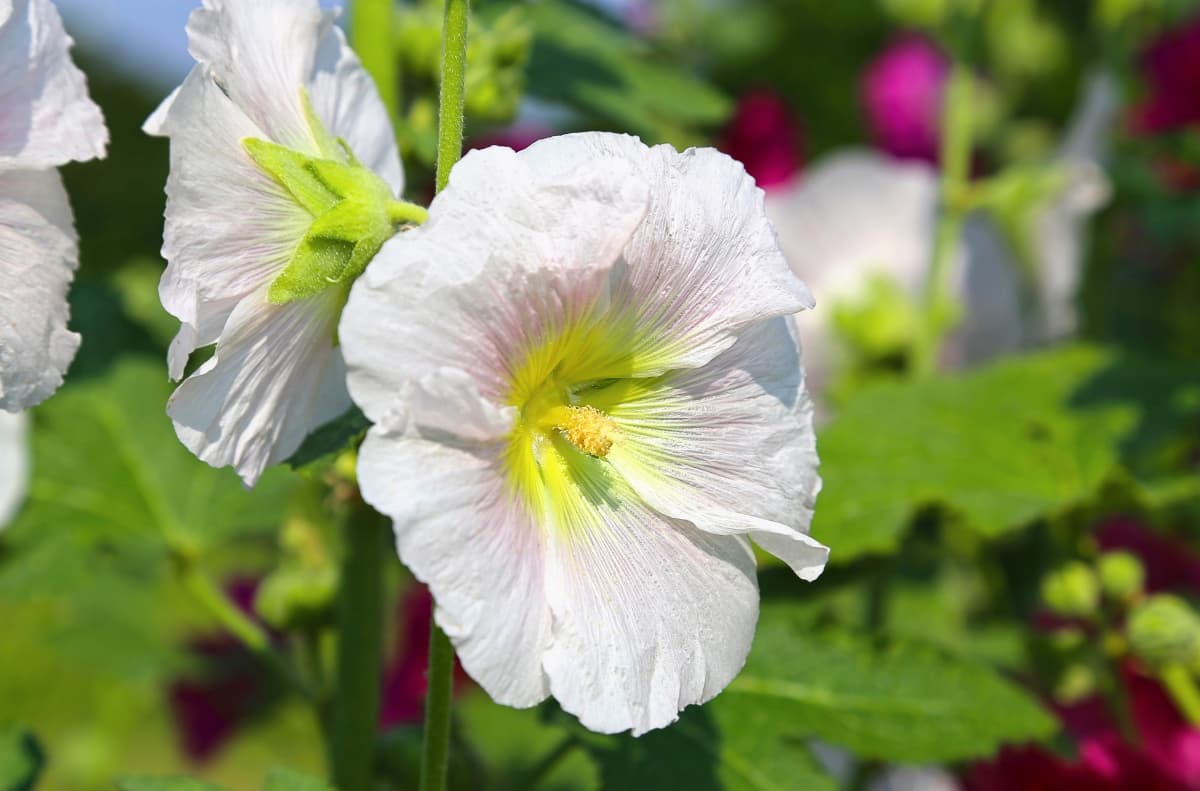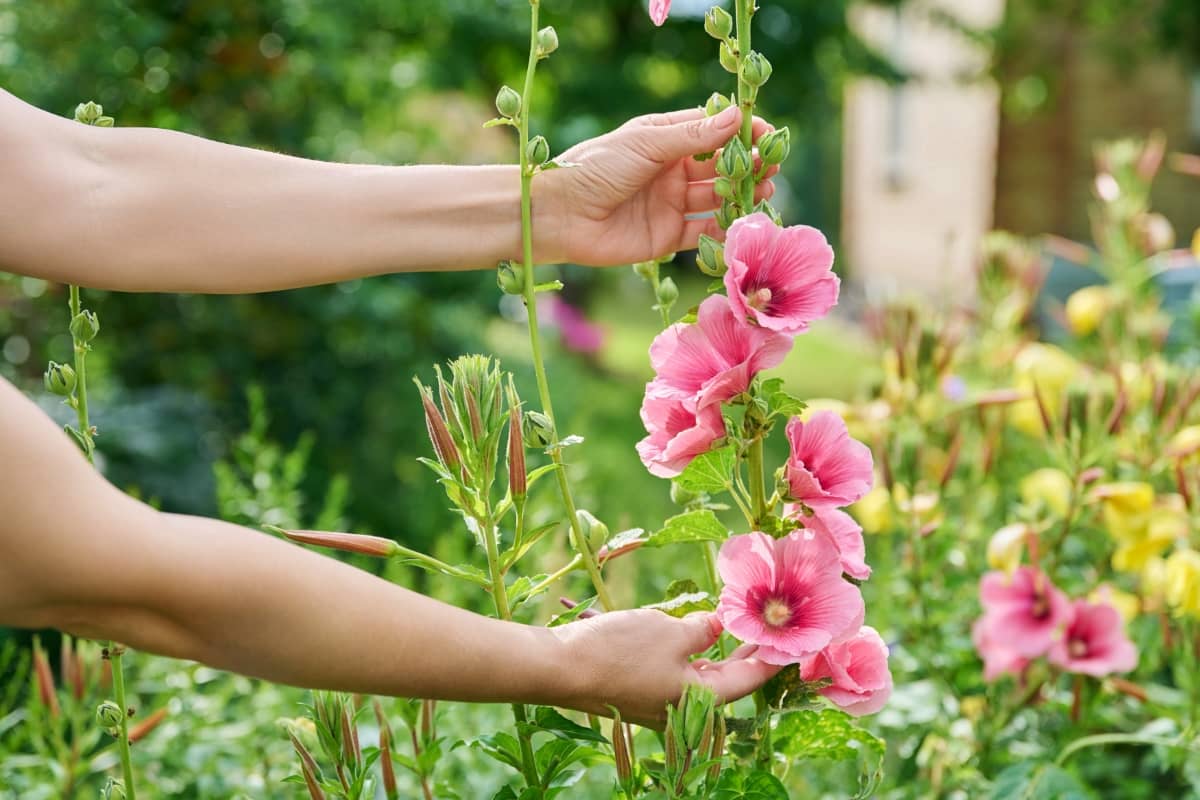With their impressive height and beautiful, striking blossoms, Hollyhocks are a classic addition to any garden. Whether you’re planning a cottage garden or simply want a burst of color against a fence or wall, these hardy perennials are an excellent choice. Growing hollyhocks, however, might seem daunting, especially for beginners. Fear not, for this guide aims to simplify the process, taking you through everything you need to know, from planting to nurturing and even propagating your hollyhock plants.

How to Grow and Care for Hollyhock
Choosing the Ideal Location and Soil for Hollyhock Plants
First and foremost, finding the best location and kind of soil for hollyhock plants is paramount. Hollyhocks, being sun-loving plants, thrive best in locations where they can soak up full sun exposure throughout the day. A spot against a south-facing wall or fence is ideal as it can shelter from strong winds and keep the long stems from breaking.
The location should also provide ample space as hollyhocks can grow up to 8 feet in height with a spread of about 2 feet. Ideal soil for hollyhocks is rich, well-draining, and slightly alkaline. It should be loose, fertile, and enriched with organic matter. If your soil is clay or heavy, add compost or aged manure to enhance its structure and fertility. To adjust acidic soil, consider adding lime to raise the pH.
Preparing the Soil and Ensuring Proper Drainage for Hollyhock Growth
The preparation of the soil and its drainage is the foundation for the healthy growth of any plant, and hollyhocks are no exception. Start the preparation by digging the soil to about 12-15 inches. This helps to loosen the soil, allowing the hollyhock’s long taproot system to penetrate deeper, aiding the plant’s stability and overall health.
Ensuring proper drainage is essential because although hollyhocks are resilient, they won’t tolerate waterlogged conditions. Poorly draining soils can lead to root rot and other moisture-related diseases. You can improve the soil’s drainage by incorporating organic matter like compost, well-rotted manure, or coarse sand into the soil. If the site’s drainage is particularly poor, consider growing your hollyhocks in raised beds or mounds to prevent water from pooling around the plants.
Watering Techniques and Schedule for Healthy Hollyhock Plants
Watering is a fundamental aspect of hollyhock care, but it’s essential to strike a balance, as both overwatering and underwatering can harm the plant. Hollyhocks prefer soil that is consistently moist but not waterlogged. In the growing season, especially in hot, dry periods, you may need to water the plants thoroughly once or twice a week.
Watering hollyhocks at the soil level is better than overhead watering to avoid water sitting on the leaves, which can cause diseases like rust. A drip irrigation system or soaker hose is a prudent option for effectively watering hollyhocks. However, the exact watering schedule can vary based on your climate, soil type, and the age of your plants. As a general rule, let the top inch of the soil dry out between waterings.
Sunlight Requirements and Best Positioning for Hollyhock Flowers
As for sunlight requirements, hollyhocks are sun-worshippers. Optimal growth and flowering of these plants necessitate a minimum of 6 hours of direct sunlight per day. The more sun they get, the better they will bloom. However, in the hottest climates, they might appreciate a bit of afternoon shade to protect them from intense heat.
When positioning hollyhocks, place them where their tall, slender stems and vibrant blooms will stand out and where they have plenty of room to grow without crowding other plants. When planted along fences, buildings, or the back of a flower bed, these plants make a stunning backdrop. They can also serve as a living screen, offering privacy or hiding unsightly areas of the yard.
Fertilizing Regimen and Nutrient Requirements for Vibrant Hollyhock Blooms
Hollyhocks are heavy feeders, and they require plenty of nutrients to produce their stunning display of flowers. Add a well-balanced granular or slow-release fertilizer to the soil when planting. Following this, an annual application of a high-phosphorus fertilizer can encourage more prolific blooms. Apply this in early spring as the plants start to show new growth.
In case you missed it: How to Grow and Care for Sago Palm: A Comprehensive Guide for Beginners

Also, supplement the soil with compost or well-rotted manure to continually improve its fertility and structure. Always water thoroughly after fertilizing to ensure the nutrients are well distributed in the soil and available to the roots. While hollyhocks are quite forgiving and can tolerate poor soil conditions, regular feeding can promote healthier plants and more vibrant flowers.
Pruning and Staking Tips for Maintaining Tall Hollyhock Stems
Pruning and staking are key to maintaining hollyhocks, especially as they reach impressive heights. Pruning involves removing any dead or diseased parts of the plant, promoting better air circulation and overall plant health. After flowering, cut back the flower stalks to near ground level to keep the plant looking tidy.
If you leave a few flower stalks, they can self-seed and ensure future generations of hollyhocks in your garden. Staking is often necessary to keep these towering plants upright, especially in windy locations. Use sturdy stakes and soft ties to support them without damaging the stems. It’s best to stake hollyhocks early in the season, as trying to stake full-grown plants can be tricky.
Identifying and Managing Common Pests and Diseases of Hollyhock
Unfortunately, hollyhocks can be prone to several pests and diseases. Rust is a common problem, showing orange-yellow spots on the underside of leaves. To manage this, remove and destroy infected leaves and apply a suitable fungicide. Avoid overhead watering, as wet leaves can encourage the disease.
Hollyhocks can also attract pests like Japanese beetles and aphids. You can hand-pick beetles off the plants or use an insecticidal soap for aphids. Regularly inspecting your hollyhocks can catch any issues early before they become significant problems.
Winter Care and Protection for Hollyhocks in Colder Climates
In cold areas, hollyhocks require special attention to survive the harsh winter. After the plants die in autumn, trim the stems and add a thick layer of mulch around the base to shield the roots from freezing. In spring, when the ground thaws, remove the mulch to encourage new growth.
Companion Planting Options to Complement Hollyhock in Your Garden
Plants with a shorter stature that enjoy similar conditions, such as foxgloves, delphiniums, or yarrow, can be great companions for hollyhocks. These plants can fill in the space around the base of the hollyhocks, creating a layered effect and adding more interest to your garden. Additionally, aromatic herbs like lavender or sage can deter pests and are suitable companion plants for hollyhocks.
In case you missed it: How to Grow and Care for a Christmas Cactus Houseplant: Instructions for Beginners

Conclusion
Growing hollyhocks is a rewarding practice that even beginners can undertake successfully. By providing the right location and soil, ensuring proper watering and sunlight, feeding regularly, and performing necessary maintenance like staking and pruning, you can enjoy spectacular hollyhock blooms year after year.
- Feed Your Flock for Less: Top 10 Tips to Save on Chicken Feed
- Ultimate Guide to Ossabaw Island Hog: Breeding, Raising, Diet, and Care
- Hatching Answers: The Top 10 Reasons Your Chickens Aren’t Laying Eggs
- Eggs and Economics: Breaking Down the Cost of Raising Backyard Chickens
- Defend Your Greens: Proven Methods to Keep Iguanas Out of Your Garden
- Ultimate Guide to Cinnamon Queen Chicken: A Comprehensive Guide for Beginners
- Ultimate Guide to California Tan Chicken: Breeding, Raising, Diet, Egg-Production and Care
- Ultimate Guide to Marsh Daisy Chicken: Breeding, Raising, Diet, and Care
- 10 Types of Chicken Farming Businesses You Can Start for Profits